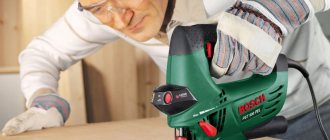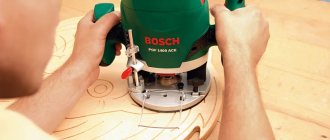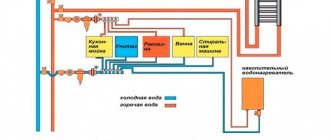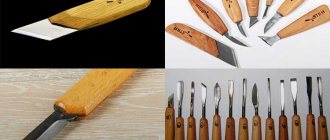Technical features
A jigsaw for wood becomes indispensable when you need to form a complex figure on the surface of plywood, and if you change the blade you can work with metal. Translated from German, the word that has become so familiar to us means a curvilinear trajectory. The design of the tool is simple:
- arcuate frame;
- lever;
- clamps for attaching thin, narrow cutting parts.
The saw blade makes cuts; this is its main functional part. Therefore, how high-quality and sharp the metal strip will be depends on the quality of the work performed. In addition to hand-held devices, there are also jigsaws. They do not replace in any way, but they effectively complement each other.
If you have to cut through a thick, dense piece of wood, use an electric device, but when thin, careful processing is necessary, you cannot do without a hand tool. In addition, it costs less than its electric counterpart, and it is safe to start working with it.
Children's jigsaw
Teachers recommend buying a children's jigsaw for crafts during labor lessons. A convenient tool allows you to make cuts and cut out shaped holes.
Depending on the installed saw, material of different strengths is cut into the frame:
- plastic;
- metal;
- drywall;
- ceramics;
- tree;
- plywood;
- sheets of chipboard or fibreboard.
The master directs the device along the line he needs. It can change direction and process the edges of workpieces thanks to the clearance between the frame and the saw. Figures are cut out both internal and external. The blade is easily removable, which allows you to make cuts of complex configurations. After completing the saw steps, you can:
- replace;
- install;
- thread into a circle;
- continue processing according to the planned scheme.
To solve different problems, jigsaws of different designs are used.
How to choose a jigsaw
The first thing we need to do is choose a jigsaw. The choice depends on our individual needs and the budget we want to spend on the purchase.
- Before answering the question of what type of jigsaw to choose, you need to decide in advance about the type of work for which it should be used. In addition, the effective and durable operation of a particular tool often depends on many other factors.
- For example, the power indicator largely determines the quality of its operation. This is especially true when it comes to large volumes of work. Jigsaws can be 200-1000 W. It is best to give preference to a more powerful tool, as it will be more functional.
Of course, you should pay special attention to the technical parameters. Let's look at the most important of them:
Jigsaw power
It must be precisely specified by the device manufacturer. Power affects the operating time of the machine, and often the maximum depth of cut. Remember that jigsaws with the most power can provide us with long and trouble-free work.
Less power means more frequent breaks. This is very important, because long-term use of the device can lead to overheating and, as a result, complete failure.
Maximum cutting depth
This is an important parameter that shows the maximum thickness of the material being processed. The maximum cutting depth is indicated for one selected material (wood, metal or plastic).
- Number of movements per minute - this parameter allows you to determine the speed at which the tool will cut.
- The more movements per minute, the better. The basic, weakest jigsaws reach about 400 movements per minute.
- They are suitable for basic work, but do not provide much comfort in use.
- Better and more powerful jigsaws can perform up to 3000 movements per minute.
- These are devices designed for more demanding users who plan to use the device frequently.
Blade holder type
Another important parameter on which the accuracy of the tool and the comfort of its use directly depend. Most manufacturers offer jigsaws with three types of handles.
- The T symbol indicates a single tab pen type. Usually mounted on high-quality and more powerful jigsaws. One tab means greater operating comfort and increased safety of use.
- Handles marked 2T are products with two reeds. This solution has now been abandoned and 2T handles are now only found on older models.
- The third type is universal handles, indicated by the symbol U. All types of blades can be installed on a jigsaw with a universal handle. Thanks to this feature, the functionality of the entire device is increased.
Characteristic features of the tool
Hand jigsaw for wood for schoolchildren
For a novice craftsman, especially if he is a child, it is better to buy a manual jigsaw for wood for a schoolchild in order to gain experience and not break the file.
This is the most fragile part of the tool, which has a different shape and arrangement of teeth. This is how a straight blade with double teeth is used to make cuts in wood and plastic along a straight line. The spiral type of cutting part is used for curved, winding trajectories. Specialists in decorative crafts work with this kind of fabric. The shape of the frame varies:
- rounded;
- pointed;
- rectangular.
This part is made from materials:
- aluminum;
- gland;
- titanium;
- become.
Aluminum frames are not durable. For long-term use, buy tools made of metal alloys. The steel base will withstand the loads exerted by the master’s hand. There are basic factors that should be followed when choosing a tool:
- the shape of the frame determines how long the cut can be made;
- the structure will not break due to the applied efforts, but will spring back thanks to the good raw materials used for production;
- strength is determined by the height of the product; this size should not be greater than the length so that the rigidity of the device does not decrease;
- the methods of fastening the file, the length of the nuts, and the diameter of the thread must be correctly selected in order to securely fix the blade.
When purchasing, pay attention to the design of the clamps. It's good if there is a thumbscrew installed there. Simple nuts will have to be unscrewed by selecting the size of the keys. They take into account the status of the manufacturer, which has become known to the consumer for the quality of its products.
How to make the right choice?
To make the right choice and purchase a manual jigsaw for wood, you need to take a close look at a few things. First, pay attention to the shape of the tool. For example, a rectangular jigsaw is suitable for some purposes, while a pointed jigsaw is suitable for others.
The weight of the tool is also important. Working with a hand jigsaw is a long and tiring task; your hand gets tired quickly. For this reason, it is worth choosing light and comfortable manual jigsaws that have anatomical handles (shaped like a hand). It is noteworthy that lightweight devices are produced by foreign companies, while Russian companies focus on quality, which means they have a significant weight.
Jigsaws have different frames. It can be made of aluminum, iron, steel and titanium. If you need a durable tool, then you should not buy devices with an aluminum frame, because the strength of aluminum is quite low. The steel or titanium option is, of course, more expensive, but you will get a high-strength product, and the saw blade will not “jump” during the cutting process.
Pay attention to the jigsaw clamps as well. They are different:
- drums
- nuts
Drums will be preferable because they guarantee more comfortable work with the instrument. You don't have to take a set of wrenches with you to change the blade. You will only need to unscrew the drum and replace the blade yourself, without using other tools.
The manufacturing company also plays an important role. You should not buy Chinese hand jigsaws - they do not inspire confidence, and their service life is very short. Among the world-famous manufacturers, it is worth highlighting Stanley and Intertool, as well as Mastertool and Topex. Such companies produce not only jigsaws, but also a line of other construction and carpentry tools.
A hand jigsaw is ideal for working with thin boards, as well as for creating small wooden crafts. However, such a device is not suitable for sawing workpieces whose thickness reaches 40-50 mm.
Jigsaw assembly
A hand-held jigsaw for wood can be turned into a universal one, and can be used to process materials of various properties. To do this, you need to learn how to change the working surface.
Hand jigsaw for wood
If the saw is positioned incorrectly, it will be difficult to work with the workpiece. When installing the actuator, the ends are clamped by 2 mm. from the edges, and the teeth are directed towards the handle. To do this you need to do:
- fix one end of the canvas near the handle;
- compress the arc along the edges, secure the opposite side with other hardware, the emphasis can be placed on a workbench or tabletop;
- After installing the file in the groove, tighten the nut.
Depending on the method of fastening, a wrench or pliers are used if there is not enough strength for manual fixation. When working with a frame in the form of a tubular arc to tension the saw, the base is installed in the grooves. They can be in a table or other device; you need 2 rounded recesses into which a jigsaw is inserted, then tightened.
Discussions
Hello. Are other files suitable? For example, Jigsaw file Bahco 302-55W-12P
Hello Dmitry! This file will do.
Hello, can you tell me which wood saws from those available are suitable for this jigsaw?
Hello, Mozhaev Sergey Alexandrovich! The following model is suitable: Jigsaw blades (125 mm; 20 pcs.) Russia 24050
Can't other similar files be used? I don't see much of a problem here
When will the files for this jigsaw be available?
Hello Olga! There are no files yet. VseInstruments.ru
Does the jigsaw come with a file, or without files (only a jigsaw, i.e. you can’t cut anything with this purchase)?
Principle of operation
Hand jigsaw for metal
A manual metal jigsaw means that it can process alloys no thicker than 1 cm.
The strength of the material will not allow working at high speed; the physical strength of the master will not be enough for this. A steel file for such finishing is chosen with a high carbon content in the alloy and fine teeth. But regardless of what work needs to be done, the principle of operation of the jigsaw is the same.
If a worker is sawing a log with a simple saw, the cutting occurs while pushing the tool away from the body of the actor. The jigsaw cuts the object in reverse when the master pulls it towards him. The beginning of creative actions consists, as in any field of production, from preparing the workplace and securing the desired canvas in the frame. Processing is performed in the following order:
- select a workpiece, determine the configuration of the cutting, if necessary, transfer the design diagram onto the surface of the product using carbon paper or fill in the outline with a pencil;
- fix the stand on the workbench or tabletop with clamps, attach the part to it and begin to cut out.
The worker sits comfortably and holds the jigsaw with the handle down. The tool must be in a vertical position and move freely from top to bottom. If the clamps hold the blade tightly, there will be no movement along the cutting line. When it is necessary to change direction to perform a curved pattern configuration, the workpiece is moved, the actuator remains in the same position. To cut an acute angle, saw until the saw begins to turn freely, otherwise the applied force can damage the quality of the design and the blade itself.
When forming patterns, a mark is made in the center of the workpiece, a hook for starting work.
Drill a hole with a small diameter drill, then insert the blade without a frame, after which you attach the base with a handle and begin sawing. The master will distribute the sizes so that chips do not form. Upon completion of work with a jigsaw, the sawed areas are sanded with sandpaper, and the figure is varnished or painted.
Device and characteristics
It should be noted initially that the tool is divided into two large classes: manual and electric jigsaws.
The former are more suitable for fine and precise work with small elements, while the latter are in most cases used where it is necessary to quickly make a shaped hole or make a straight cut.
The design of a manual jigsaw is extremely simple; it consists of the following elements:
• Small arched metal frame.
It is mainly made in the shape of the letter “P” or “C” from steel.
Its main feature is the large gap between the upper part and the stretched fabric.
This allows the frame not to rest against the edges of the workpiece, but to go around them.
If it is necessary to make a cut along a line that should not extend beyond the workpiece, then a hole is drilled in it.
The canvas is then removed from the frame, passed through this hole, and reattached to the frame.
• Blade – the working, sawing part of the tool with small teeth.
It is stretched between the ends of the frame (fixed with its fastenings).
It has one big drawback - low mechanical strength, which, coupled with the small size of the frame, makes sawing at a great distance from the edges of the part impossible.
The canvas itself often simply bursts and breaks off.
• Handle – an element that is installed on one side of the frame and is designed for convenient holding of the tool with one hand.
Made from wood, metal or plastic.
A standard electric jigsaw consists of:
- Housings with a comfortable handle and a start button, in which all electrical elements are hidden.
- Electric motor with gearbox.
- Stock.
- Files.
- Guide support plane fixed in the lower part of the body.
- Various optional additions for ease of operation: backlight, pendulum switch, additional guide mechanism, laser pointer, etc.
The operating principle of an electric jigsaw is the reciprocating movements of the saw at high speed.
It is fixed in a rod, which moves due to the transfer of energy from the engine through a gearbox.
Sawing occurs perpendicular to the surface being processed.
Dimensions and weight
The most common hand jigsaws weigh 285 g with a blade length of 130 mm and a sawing depth of up to 300 mm.
But there is a tool with the following parameters:
- Weight: 120 – 450 g;
- Sawing depth: 100 – 400 mm;
- Blade length: 22 – 300 mm.
Parameters of typical electric jigsaws:
- Weight: 2 – 5 kg;
- Length: 180 – 300 mm;
- Width: 60 – 120 mm;
- Height: 180 – 400 mm;
- Saw blade length: 40 – 250 mm.
What difficulties arise during work?
The jigsaw requires a lot of patience when working
Such a tool is considered a means of completing tasks for creative people who can spend hours cutting out a technically complex structure. When they begin processing in childhood, they get acquainted with the device, gain experience with exposure in order to obtain as a result a beautiful frame or household item.
Manufacturers have tried to install a comfortable, ergonomic handle, but this still leaves your hands tired from constant tension. There are unwritten rules for preventing fatigue at a later time and obtaining a high-quality cut without breaking the blade:
- The handle is held firmly during vertical movement; the jigsaw must always be in a straight position without angular deviations, then the file will not tear.
- Achieve a neat stitch. This doesn't require much effort. Entry into the structure of the raw material occurs when the canvas moves downwards, which should easily fall under its own weight and slight pressure from the worker’s hand.
- The cutting part is also lifted up freely, friction occurs to a minimum.
- Both hands are equally occupied in the work process. One rotates the part along the curves of the pattern, the other holds the jigsaw without rotating towards the contour.
- The location of the blade should not be in the central part of the figure, but closer to the edges of the cutting line.
- Replaceable cutting inserts do not cut corners. When this cannot be avoided, the work is stopped in order to continue on the other side according to previously made markings, taking into account the necessary vertical or horizontal deviations.
- The file is installed for its intended purpose in accordance with the processing tool and the configuration of the cut. The spiral type is used for curly cuts, straight teeth are needed for the same cuts.
- Poor processing will result if the workpiece is weakly fixed; a reliable clamp is chosen and firmly attached to the work table or stand.
- Keep in mind that the tool is designed to form shaped notches, but this is not a saw, it must be handled with care so as not to constantly change the cutting element to prevent it from breaking under strong pressure. In the work process, efforts are applied with a gradual increase. The guideline is a visual assessment of the chips. It should be small and uniform. When rough grinding appears, change the mode to prevent the formation of unevenness along the edges.
- Avoid sharp turns; to do this, use a drill to create holes, remove the canvas, and insert it into a new structure.
Jigsaw
There are several secrets that figure sawing specialists successfully use.
Despite the complexity of shapes and figures, turns and bends are often repeated, so they concluded:
- An acute angle will be obtained if you bring 2 lines to one point;
- an obtuse or right angle can be made by idle movement of the blade while smoothly turning the workpiece with the second hand;
- to get a curl in the design, increase the speed of the saw together with the rotation of the product;
- beautiful patterns are achieved on thin, sanded plywood even by those who do not yet have experience operating a jigsaw.
Specialists have become very interested in polystyrene sheets. This is a durable multi-colored plastic that lends itself well to processing. Interesting things come out of it.
You need to start practicing with simple diagrams, after all the procedures begin to be carried out automatically, you can begin to more serious drawings. For example, choose the simplest patterns with straight lines, then move on to curves.
There are specific conditions for successful work that must be followed for any amount of work. After every 60 minutes of hard work, you need to take a break and devote at least a quarter of an hour to rest.
Recommendations for beginners on working with the tool
It would be useful for beginners, and even experts, to be reminded of the safety rules for working with tools. Please print these instructions and place them in an accessible place. These points are mandatory. For safe operation it is necessary:
- Make sure the saw blade remains stationary by securing it to the device.
- Increase pressure on the saw blade gradually, ensuring smooth operation. This approach will allow us to produce high-quality products.
- Work with the file in one direction without sharp turns. If the technician is insufficiently experienced, the part may be damaged. Gradually you can move on to rotating the tool by 15 degrees.
- To avoid deformation of the workpiece when cutting lengthwise or crosswise, you should use smooth sawing from top to bottom.
- To avoid blade breakage when the file rests on the edge of the part and gets stuck there, it is recommended to reduce the pressure on the file and turn the pin vice located on the side.
- When creating a figured pattern inside the product, you will need an electric drill to make a small hole. This is done to preserve the integrity of the edges of the wooden workpiece. The blade is inserted into the hole made and only after that it is secured to the jigsaw.
- In order to prevent the file from jumping out of the clamps, it must be fixed by turning the handle. This maneuver requires some experience from the master, otherwise you can break the canvas.
- The file should be given maximum tension on the handle for normal sawing of wood. When planing wood, the file must be loosened.
- When cutting complex designs, it is recommended to first apply a sketch to the surface. This will allow you to avoid mistakes and get a beautiful and even workpiece.
What rules will protect against injury?
The mechanism seems harmless and simple only at first glance.
When performing any work, you must follow basic safety rules to avoid injury. There is work to be done
Safety rules when working with a jigsaw
with a sharp, metal part that hurts painfully, and on occasion will reach the bone. Before work, you need to inspect the jigsaw, check that the handle is firmly and firmly secured. If the fastening is broken during creative actions, the handle will fall off, but the hand will continue to move until it comes into contact with the metal pin. Which won't bring anything good.
A workbench or metalworking table must also be equipped with all special devices for safe work. Sometimes even a fall from a simple, unstable chair can cause injury and bone fractures.
The master always tries to take a closer look at his creation. This should not be done during work processes. If you lower your head too low, shavings will get into your eyes.
When a person gets used to a jigsaw and overcomes all the difficult moments, working with it becomes a real passion, and crafts become a source of pride. But a hobby can be combined with a source of income. Manual labor has always been valued much more than mechanical stamping.
- Related Posts
- DIY metal clamp
- Which electric jigsaw is better to choose - 2021 rating
- How to choose a spray gun
« Previous entry
Types of jigsaws
Jigsaws in general are a fairly homogeneous group of tools. However, experts distinguish among them several types designed to solve various problems.
Modern manufacturers offer four main types of jigsaws. Below we will briefly look at each of them.
Traditional jigsaws
They are very popular and available at any store that sells tools. The blade of a regular (also called classic) jigsaw alternates between moving up and down.
Force must be used when operating this power tool. While working, you need to apply pressure on the jigsaw so that the saw blade enters the material and moves along the line specified by the user.
Jigsaws with cut end
This group of products includes oscillating and pendulum jigsaws. They are slightly more expensive than traditional analogues, but at the same time more convenient to use. The scoring blade moves easily up and down, as well as forward and backward.
Thanks to the additional movements of the saw blade, we will not have to put too much pressure on the device. Pruning power tools are especially useful when cutting thicker material.
Most of them are also adjustable. Thanks to this, you can adjust the specifics of the jigsaw to the thickness and hardness of the material being cut. This feature provides convenient operation and improves cutting accuracy.
Bench jigsaws
These are devices designed specifically for professionals. They are characterized by high cutting accuracy and ease of use. This type of jigsaw is designed to work on a stable table, which provides increased cutting accuracy.
- Most often we use it for cutting large pieces of wood, metal, and also plastic. Most quality benchtop jigsaws already have dust extraction systems and plenty of adjustment options.
- The biggest drawback of this tool is its higher price. Bench jigsaws are not a good solution for enthusiasts who are not interested in making very precise cuts.
It's also worth remembering that most benchtop power tools don't have a very deep cut. Their main task is to accurately cut materials of smaller thickness.
Hair jigsaws
Hair jigsaws are characterized by the highest precision of work. They are suitable for precise cutting of elements in the shape of a semicircle or circle. In this type of product, there are so-called hair blades.
The entire device is usually placed on a stable table. It can cut both larger and smaller elements. However, it is worth remembering that a cutting jigsaw will be much more expensive than other types of jigsaws. It's not worth investing in unless you plan to make very precise, multi-stage cuts.











